
Africa's "Thunderbird" Is At Risk Of Extinction
The Southern ground hornbill, the largest of the hornbills, is a bird like no other. Its booming call can be heard from as far as 5 km away and can be easily mistaken for a lion's roar! It is so highly territorial that it even fights its reflection, often breaking glass windows in the process. In some African communities, there is a belief that even if a single feather of this bird is placed in the river, it will invite rain, and if not removed in time, the rain will never stop!
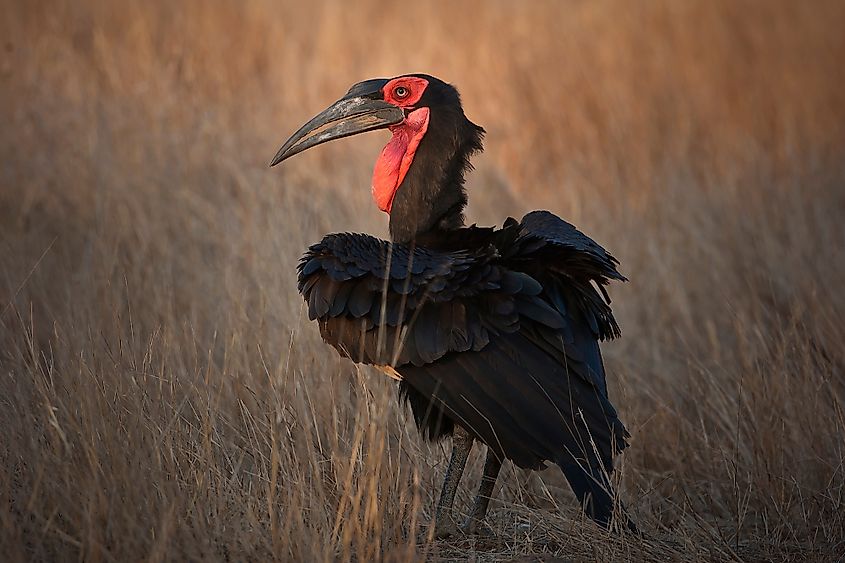
Endemic to Africa, the Southern ground hornbill is a keystone species in 16 countries across sub-Saharan Africa. It plays major ecological and socioeconomic roles across its range. As a skilled scavenger and predator, it helps maintain the health and balance of the ecosystem. Being an apex predator, it keeps the population of prey species in check. By feeding on carrion, it cleans the environment. It also acts as an effective seed disperser and bioindicator for savannah biomes. Its absence or declining numbers indicate that something is seriously wrong with the ecosystem demanding conservation intervention. The bird also attracts significant tourism serving as a flagship species for biodiversity conservation and a source of income for the locals through tourism revenue. Nicknamed the 'rainbird' and 'thunderbird,' the Southern ground hornbill is also revered by several African communities as the harbinger of rain. Some even treat the bird at par with humans giving a dead Southern ground hornbill a proper traditional burial.
Sadly, the traditional reverence for the species has been waning over the past few decades. Today, many factors conspire against its presence in its native land. Without human interventions, the species is at high risk of unnatural (human-caused) extinction and listed as 'Vulnerable' on the IUCN Red List. It is regionally 'Endangered' in South Africa, Namibia, and Eswatini, disappearing from 70% of its historical range.
About The Southern Ground Hornbill
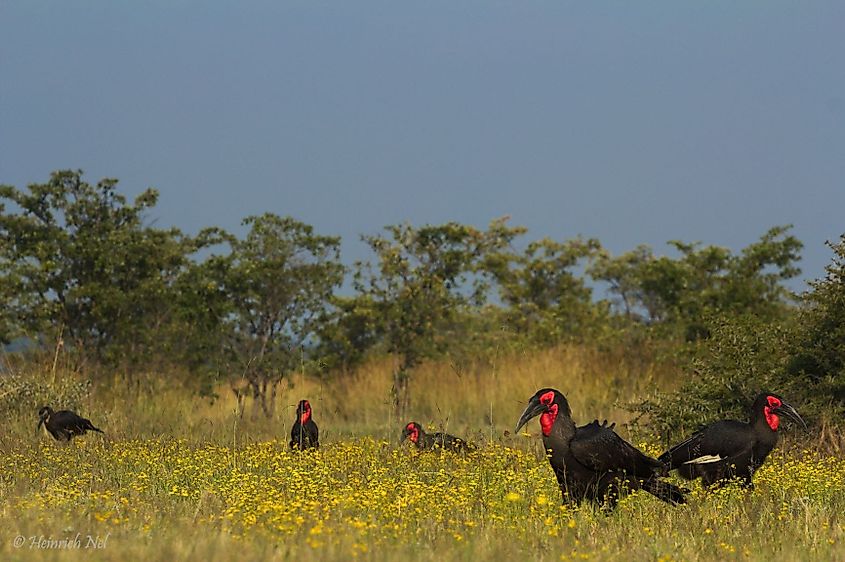
Southern ground hornbills (Bucorvus leadbeateri) are mostly found south of the equator except for a slight range overlap with the Northern ground hornbill to the north in Kenya and Uganda. They live in altitudes ranging from sea level to 3000 m with open woodlands, grasslands, and savannah.
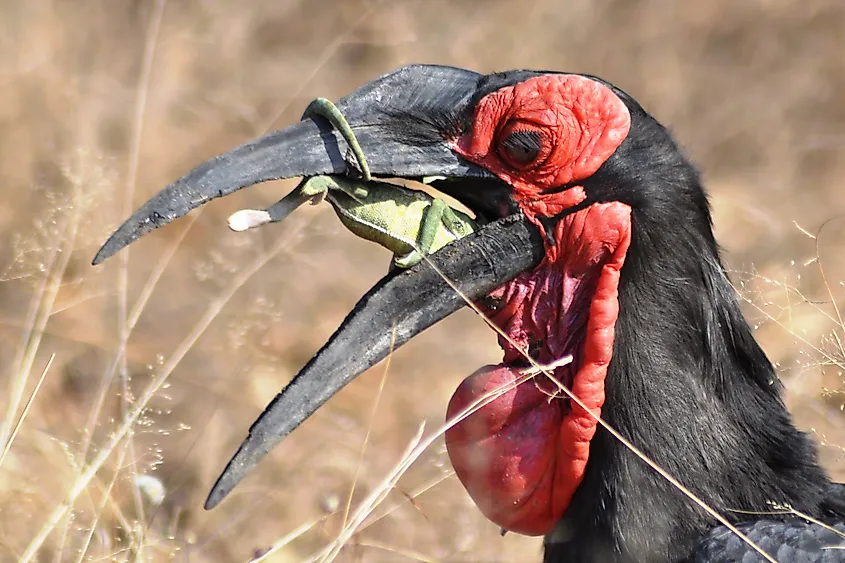
Despite being strong flyers, Southern ground hornbills spend over 70% of their time foraging for food on the ground. Reptiles, small birds and mammals, frogs, and a variety of arthropods constitute the diverse menu of these birds. Their powerful eyesight aids them in finding surface food, and when that is scarce, their strong beaks help them dig underground for food.
These sturdy birds are also the world's biggest cooperative breeding bird species. They live in groups with one alpha mating pair and non-breeding helpers (mostly former sons or beta males). The alpha and beta males take care of the female, feeding her before, during, and after the nesting period. They also take care of future chicks. Later, the beta males disperse to find their own territories. Daughters or beta females usually leave the group earlier than the sons. They might stay alone for a few years before they are ready to breed.
Declining Populations Of The Southern Ground Hornbill
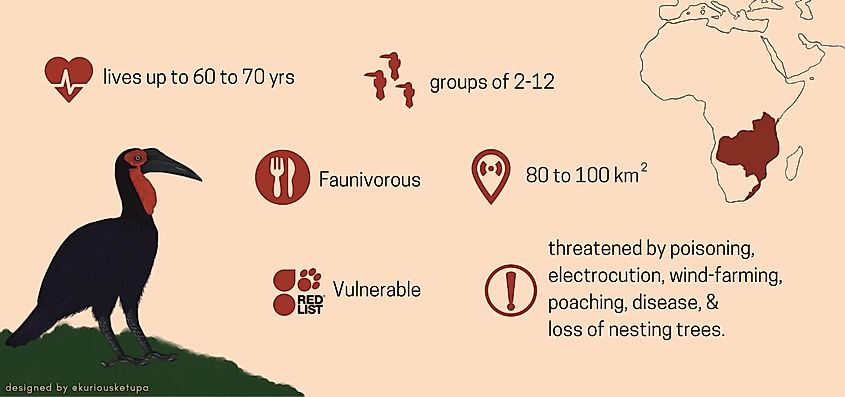
In recent decades, expansion of human settlements, over-grazing, and climate change have degraded and fragmented vast tracts of land that serve as habitats for the Southern ground hornbill. Such changes have triggered a rapid decline in the population of the species.
Conservationists like the 2021 Whitley Award winner Dr. Lucy Kemp keep hope alive for this bird. Dr. Kemp's parents pioneered research on the species in the 1970s, and inspired by them, she continues to work on the conservation of the species in South Africa. As the Project Manager of the Mabula Ground Hornbill Project based in South Africa's Mabula Game Reserve, Dr. Kemp guides a team of dedicated experts to protect the species.
"In South Africa, the Southern ground hornbills occur in the provinces of KwaZulu Natal, Limpopo, Mpumalanga and the Eastern Cape. Approximately 60% of the national population occurs in the Greater Kruger National Park, while the remainder is in communal, farming, hunting and privately-owned land. However, the numbers of these birds are continuing to decline, mostly on commercial farmland and communal grazing areas where cultural protection is no longer prevalent," Dr. Kemp informed WorldAtlas.
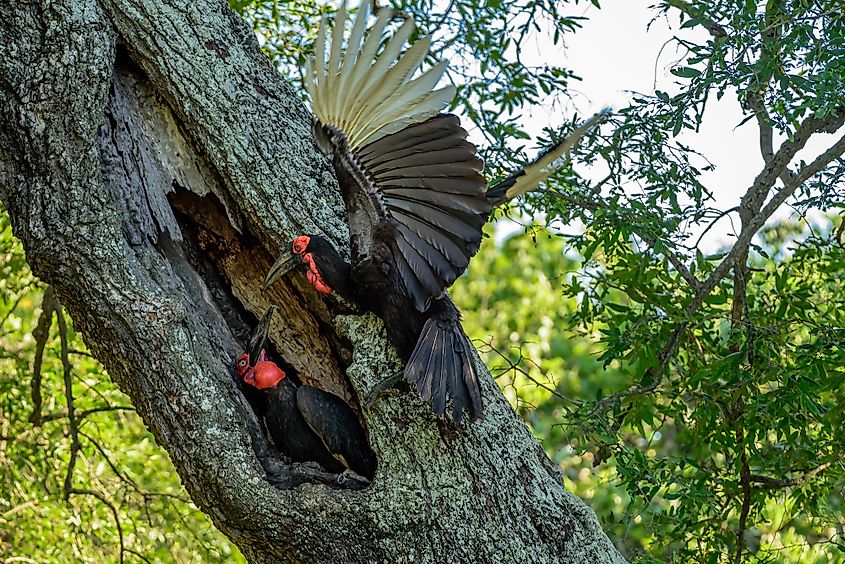
The loss of nesting trees is also a significant issue. Removal by humans and elephants and, to a lesser extent, natural disasters have led to these birds struggling to find a home for raising their young ones. Trees with sizeable cavities serve as ideal nesting sites for these birds, which center their territories around such trees.
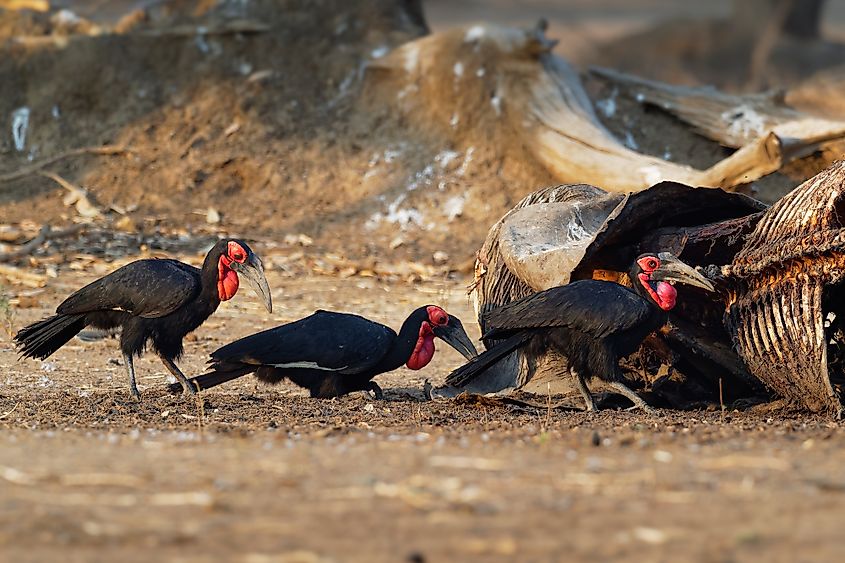
The species' scavenging habits make it highly susceptible to poisoning. Often, lead fragments from bullets used to kill wildlife during hunting expeditions remain lodged in the discarded tissues and offal of the hunted animal. When Southern ground hornbills feed on such remains, they can die due to lead toxicosis. Intentional lacing of carcasses with poison to target carnivore species or poisoning of crop-raiding birds leads to secondary poisoning of the ground hornbills when they feed on the poisoned dead animals.
The traditional belief that these birds can attract rain has also led people to hunt them for their feathers used in rain ceremonies, especially in times of drought.
Southern ground hornbills' territorial behavior also lands them in trouble. They attack their reflection on mirrors, glass windows, or vehicle bodies, thinking it is an intruder causing property losses to people. Retaliatory killings fuelled by public wrath often follow.
The breeding pattern of the species also deters its conservation. Southern ground hornbills are a slow breeder; they mature after about ten years, spending over five years in parental care, learning the survival skills, and taking care of the younger ones. And although they can survive for up to 70 years, the breeding interval is usually several years long. Only two eggs are laid per clutch in 80% of cases, with a gap of 3 to 5 days between the two. The first-hatched usually survives while the second chick is neglected (even when plenty of food is available) and perishes due to dehydration. Researchers are yet to find meaning in this strange phenomenon. They hypothesize that the second chick acts as an insurance policy if the first one fails to survive.
Conserving The Southern Ground Hornbill
Given the challenge of multiple threats, the conservationists at the Mabula Ground Hornbill Project have adopted a multi-disciplinary approach to slow the population decline of the Southern ground hornbill. Founded in 1999 by Ann Turner, the organization focuses solely on Southern ground hornbill conservation.
"Our work is currently focussed outside of protected areas (although we conduct monitoring and chick harvesting within protected areas) primarily in South Africa, and our activities also include outreach to neighboring range states through local partners," mentioned Dr. Kemp.
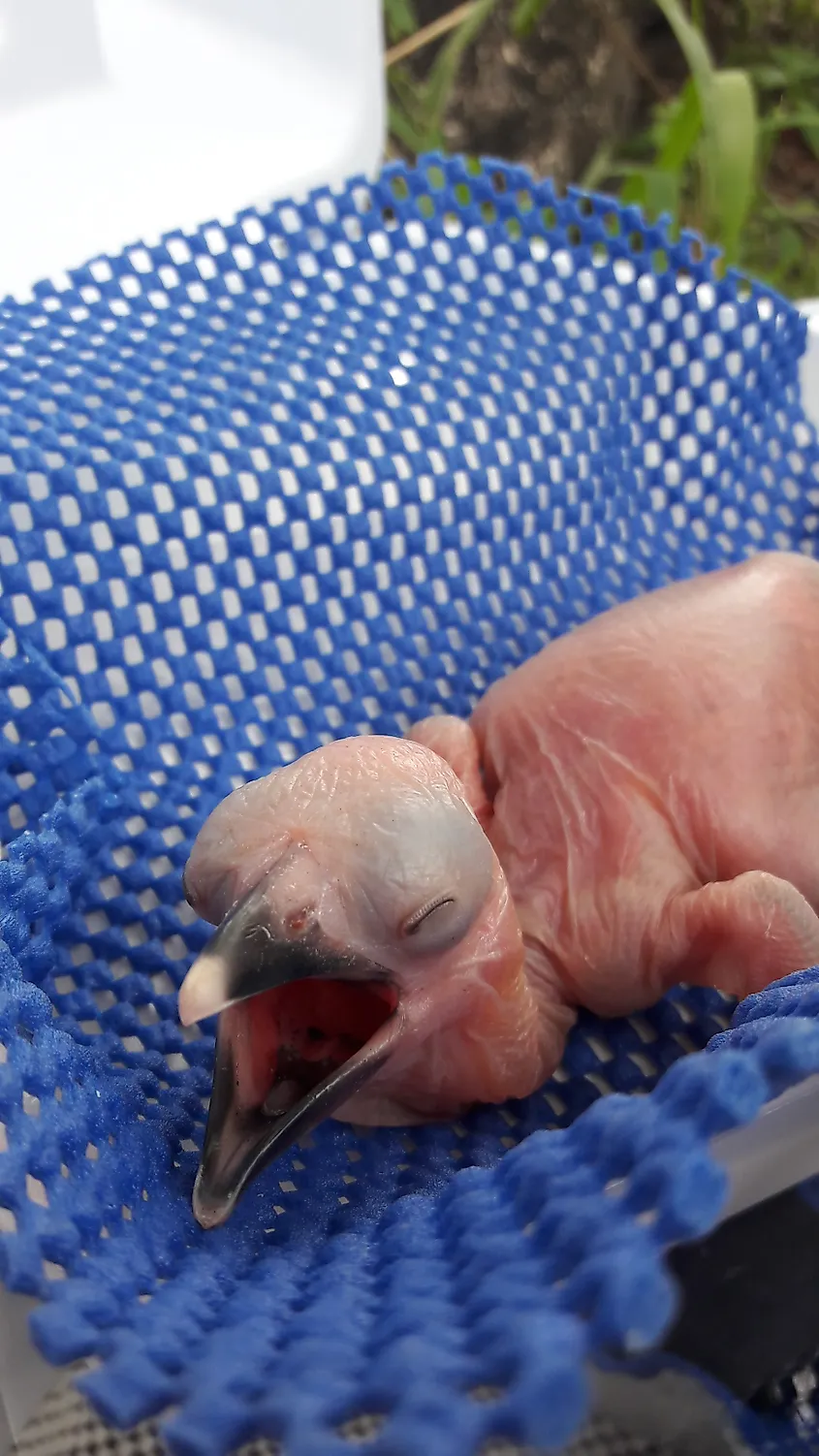
The Mabula team has successfully reintroduced new groups of Southern ground hornbills into areas that lost the species. The second-hatched chicks (that would otherwise die in the nest) provide a redundant source of reintroduction stock to the researchers. They extract these chicks from the nests and bring them up under controlled conditions. Once ready, they are released to boost the wild populations of these birds.
The team is also researching novel methods of threat mitigation. For example, they have partnered with a local university to design a new artificial nest prototype that is climate-change-proof and strong enough to last for most of a breeding ground-hornbill female's lifespan.
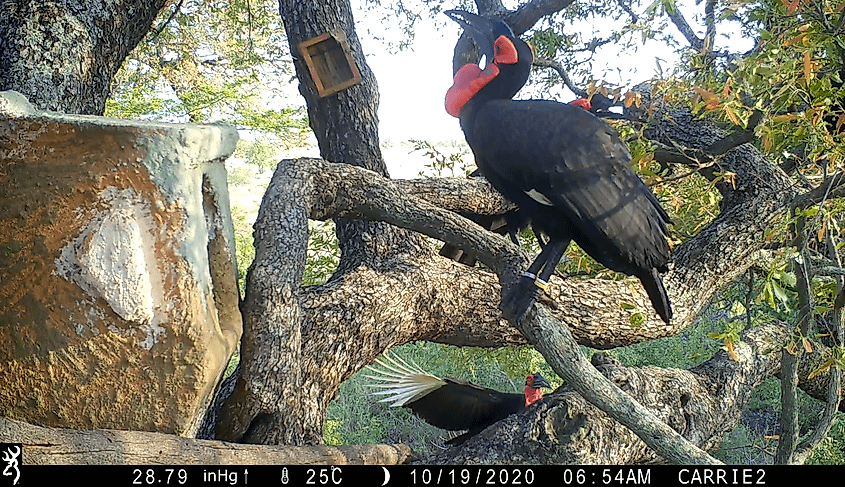
The Mabula Ground Hornbill Project collaborates with other organizations conserving threatened species that face the same threats as Southern ground hornbills to lobby for policy and law change. The researchers also implement behavioral change in the people who share the environment with these species.
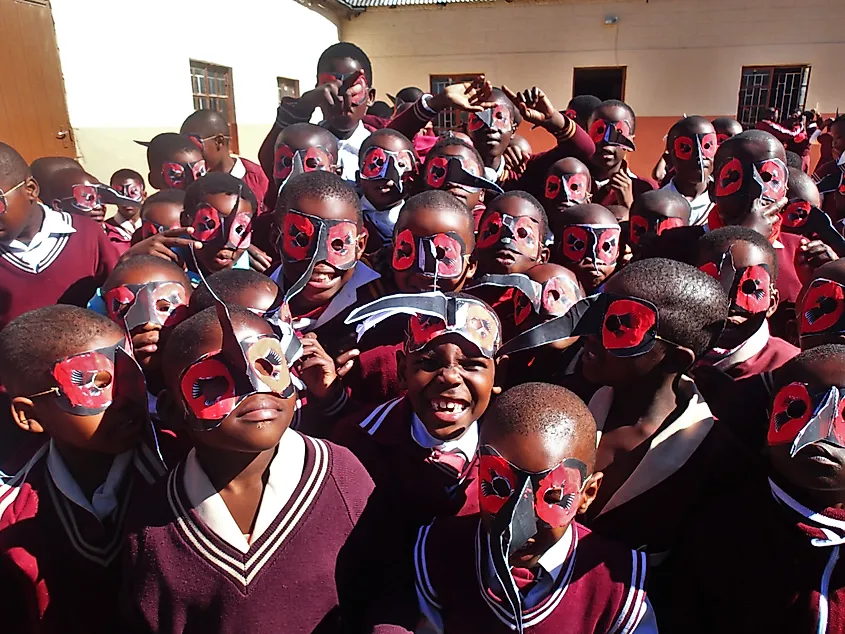
"We go by the cooperative approach, where we seek to work with the people who are the source of some of the threats in developing practical solutions to the threats," said Dr. Kemp.
Being key indicators of environmental health, the survival of Southern ground hornbills is essential to conserving the biodiversity of the ecosystems where they occur. But in the face of growing challenges, the conservation of these birds becomes increasingly difficult.
"The Southern ground hornbills are an integral part of African landscapes, one of the most well-recognized bird species in the continent. The more we lose, the harder it will be to recover what has been modeled to go extinct without conservation intervention. These birds play an important ecological and cultural role, and their disappearance from the savannah would be irreparable," mentioned Dr. Kemp.











